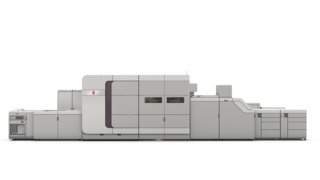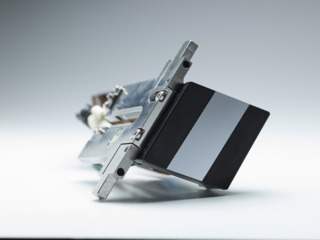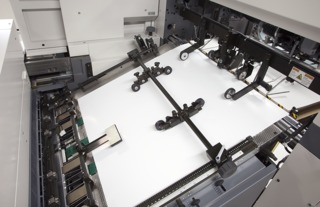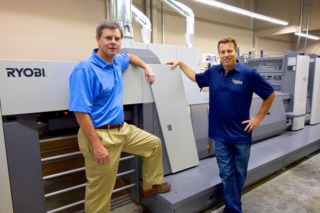The Latest Half-size (‘B2’ Format) Presses in Digital and Offset
What print language do you speak? Twenty inch? Three-quarter format? How many up? Whatever we call it, it works.

Half-size, three-quarter format, 20x28 (give or take a few inches): The perception of what many printers once described as “B2” size presses is changing, according to industry observers and original equipment manufacturers.
In the print-on-demand space, several B2 size inkjet presses now are satisfying the product and quality needs of the commercial printing market, including short runs, fast turnarounds, high registration accuracy, and the use of variable data. Screen’s Truepress JetSX, for example, is a B2-format duplex printing system that boasts quick startups and production flexibility to handle diverse applications requiring offset quality. The B2 size is familiar for most print firms and, therefore, easy for them to navigate, especially when it comes to workflow: from paper-buying economies of scale to the corresponding sizes of finishing devices.
As many as 390 billion pages may be available to print digitally by 2019, according to Canon Solutions America (CSA) projections. “The make-up of these pages is promotional materials, such as direct mail,” explained Francis McMahon, senior VP of marketing at CSA, “as well as specialty items like calendars and holiday cards.” Then, there are publications. “Black-and-white, on-demand books represent some 70 percent” of those 390 billion pages, McMahon added. And although declining, transactional printing still represents a healthy chunk: as many as “60 billion pages,” he noted.
HP estimates that it produced 3.2 billion B2 pages on its digital presses in 2015, which averages out to approximately 300 million pages per month. In the nearly four years since the 20.9x29.5-inch HP Indigo 10000 Digital Press caused substantial buzz at drupa 2012, HP reported it now has between 250 and 300 of the five-up devices in the field. The 10000 model can print as many as 4,600 color B2 size sheets per hour and now supports white ink and up to seven ink stations – evolved functionality akin to other HP Indigo presses.
Building dry-toner engines wide enough to handle B2 formats is challenging for manufacturers. Only Xeikon (now owned by Flint Group) has done it with any commercial success. Most every other OEM sticks to SRA3 widths of 12.6 inches x 17.7inches, although there are increasingly more long-sheet models coming to market that can print 26-inch and even 39+ inch lengths.
B2 Digital
Interestingly, some 30 percent of HP Indigo 10000 customers have purchased more than one of the digital presses. One such firm is GLS Companies, Brooklyn Park, MN, which added two HP Indigo 10000 Digital Presses in 2013 and 2014, respectively. The company also has conventional web and sheetfed presses and has been an HP Indigo customer since first moving into digital print in 2004. GLS’s equipment list also includes HP Indigo 5000 and 7500 Digital Presses and HP SmartStream Production Center.
“We knew what HP presses could do, but the B2 format was what we wanted in a digital press,” explained marketing director Jim Benedict. “GLS Companies was one of the first in the U.S. to install an HP Indigo 10000 to support our direct mail business with highly targeted, one-to-one personalization. We have seen steady growth in our digital variable product offering since installing the first press … leading us to install a second HP Indigo 10000 to meet client demand.” Prior two the first 10000’s arrival three years ago, GLS had produced direct mail on roll-fed inkjet presses and its B3 size digital devices. Using a 20x29 sheet, however, provides more flexibility for creative folds and other types of applications.
The manufacturer has planned upgrades rolling out for the series, the latest of which feature a “new level of reliability, uptime, and print quality,” said Ed Wehbe, category manager for the HP Indigo Commercial Print unit. As print volumes on the 10000 model have gone up, HP engineers have been focused on fixing bugs and adding enhanced sensors and newer hardware, he added. “Restart jam rates are declining.”
JDF-compliant workflow automation is another Indigo advantage cited by Jacob Shamis, formerly of the Indigo division who now is Americas market development manager for HP Indigo and PageWide Web Presses. “Imposition also is more efficient,” Shamis said. “For example, 6x9 postcards can be run nine up.”
Bennett Graphics, Tucker, GA, a family owned PSP that produces internal and external communications materials for non-profit organizations, colleges, and universities as well as small graphic design agencies, added an HP Indigo 10000 Digital Press in mid-2013. President David Bennett moved short-run offset jobs of between 2,500 and 3,000 sheets to the digital press and said he also is winning other types of work. Its wider format enables the firm to produce larger format applications, such as posters and oversized brochures, which it could not previously support through digital printing. The press also has raised the crossover point between digital and offset production, allowing the company to print longer-run digital jobs at a lower cost.
To date, HP Indigo also has 20 or more installations of the 30000, the B2 sheetfed press that mainly prints folding cartons and heavy board, according to Ralf Schlozer, director of InfoTrends’ On Demand Printing & Publishing Consulting Service in Europe.
More B2 Inkjet
In the B2 inkjet world, Fujifilm’s Graphic Systems Division offers the four-up (8.5x11 inch), 20.9 x 29.5-inch J Press 720S, a four-color model where the “J” stands for Jet. The J Press “runs variable data at speed – not half speed,” pointed out marketing VP Terry Mitchell. A barcode reader on the feed side enables variable data and graphics to be indexed and matched to specific sheets on the fly; integrity is ensured even in the case of a misfeed or other mix up, he noted.
The digital sheetfed press’s most endearing feature, however, may be Fujifilm’s Rapid Coagulation Primer (RCP). Each sheet is treated inline with RCP, allowing the J Press to print on many standard offset papers. RCP works in conjunction with Fujifilm printhead and ink technology to jet two-picoliter droplets of aqueous pigment-based inks resulting in printed output that “looks and finishes like offset,” Mitchell said. “It has been very well received.”
A J Press service improvement comes in the form of its printheads, which no longer are housed in a bar, Mitchell reported. Now, the heads are individually replaceable. The drying system also has changed to a combination of infrared and an airflow system that uses knives to drive air through the sheets. Engineers have opted for an aqueous ink set, making the inkjet device’s impressive image quality even better. In addition, printed sheets can be laminated or aqueous-coated just like offset.
The J Press customer profile is a print mash up: There are the traditional print service providers (PSPs) with offset equipment, according to Mitchell, looking to meet increasing demands for shorter run lengths and multiple versions. Then there are the digital-only, web-to-print houses, which operate under a completely different business model, specializing in quick turns and shipping same-day orders. “There also are specialty users, too, like book printers doing covers and direct mail companies,” he said. “The challenge for all of them is to do digital cost-effectively.” While “clicks” may make costs easier to calculate, in Screen and Fujifilm’s case there are no click charges. Instead, they run on a consumables model: “So, lower ink coverage equates to lower costs, while print jobs requiring higher ink coverage will cost more but about the same cost as a click,” Mitchell explained.
Printing margins continue to be squeezed as run lengths plummet, driving overall production costs higher. Obviously, “a 1,000- or 1,500-piece inkjet job doesn’t have all the makeready and printing plates that offset requires. The mentality out there is changing, but it’s a work in progress. Today, we are getting questions from customers and prospects about cost per sheet,” Mitchell said, adding that the old-school days of printers quoting cost per thousand are all but gone.
The capital costs of printing using inkjet technology have come down somewhat, Mitchell continued. “Ink and paper costs have decreased considerably,” he said. But today’s customer mindset has more of a marketing slant, taking response rates into consideration. “It’s true that there is less print overall, but it is proven that more targeted pieces, using individualized data, get better response rates: up to 5 percent” versus 1 percent for static print. “But an offset printer would take it on the chin printing 500 each of four different versions as opposed to one version of 2,000 pieces.”
Offset press manufacturer Komori also is playing in the digital game with its 23x29-inch Impremia IS29 inkjet press, a four-color sheetfed machine featuring high-quality resolution of 1,200 dots per inch and output speeds up to 3,000 sheets per hour. The technology enables the use of normal printing paper, Komori said, and also matches the OEM’s offset colors.
The Impremia, first announced nearly four years ago, got its first U.S. beta site in 2015. Chicago-area marketing services provider SG360° (formerly known as Segerdahl Group), Wheeling, IL, now is testing Komori’s highly anticipated inkjet press. The $300-million firm’s new CEO is Mary Lee Schneider, former chief technology officer of RR Donnelley and, during a 20-year career, president of the mega printer’s Digital Solutions group.
Sheetfed Offset, Too
Purchasing even a new B2 digital press can be cost-prohibitive for smaller print firms, in access of a $1-million investment for some models, warned Chris Manley, president of Graphco, the Cleveland-area equipment dealer that hawks both digital (MGI) and offset (RMGT/Ryobi) presses. “A lot of smaller-format [offset] presses are being sold,” Manley added, largely due to the shorter run lengths still prevalent throughout the industry.
And then there’s over-capacity, of course, which still plagues printers. The attrition rate for larger presses definitely is higher, Manley added, citing the equipment auction emails many of us receive regularly: “Probably 95 of 100 auctions have full-size, 40-inch machines” for sale, he observed.
Why go smaller? Manley cited three main reasons if your shop uses, on average, between 7,500 and 10,000 sheets or fewer per job:
- Less volume: If you are a “short-run printer,” turning increasingly more jobs but at fewer quantities, the smaller format size features faster makeready and uses less waste paper to get “up to color.”
- Flexibile job change-overs: With more jobs in the queue, changing sheet sizes is easier and quicker on a smaller printing press. Time is money in a short-run environment.
- Hourly rates are less: A lot of print service providers (PSPs) don’t have or want full-size equipment, and they never will, Manley said, because these owners and managers like being able to run a press with a single operator. Most full-size, 40-inch presses require twice the labor, or two operators.
From a paper-buying perspective, printers can run eight-page signatures on larger presses using 24x36 inch sheets, which is a standard stocking size, he continued. Being able to run six 8.5x11 inch pages in “three-quarter format” is a strong lure, Manley said.
About a year ago, commercial printer The Messenger Press Inc. installed a 24x31-inch Ryobi MHI 755XL GP perfecting press with aqueous coater at its Carthagena plant in northwestern Ohio. Mitch Kremer a 30-something COO working side by side with his father, Allan, made a conscious, total-cost-of-ownership decision not to move “up” to an eight-up machine, saying he did not want to have to buy a bigger plate-maker and a bigger cutter. The press is providing Messenger with significant increases in productivity and enhanced print quality as the Kremers grow their presence throughout Ohio and the Midwest.
“This will be our main production machine for short-run offset,” reported the younger Kremer, who joined the now 134-year-old firm seven years ago and became a VP in early 2012. “It will bring us into the next 10 to 15 years.” Messenger replaced a 2001 vintage six-color (2 over 4) sheetfed perfector from a different manufacturer.
“There is a lot more automation on the new press,” Kremer added. “There is better registration and less makeready, which means it is quicker and we can turn more jobs in a shorter [amount of] time,” he said. “One of our goals is to get to sellable color while wasting less paper” on the direct mail and other work printed at Messenger Press. One feature that the Kremers and their team like is the robust feeder. “It’s beefed up and is more heavy-duty, with less strapping,” Mitch noted. “[Running at] 16,000 sheets per hour helps on all of our work, and with no electrical cabinet near the feeder there’s more room to work.”
Kremer traveled to RYOBI MHI customers in Cleveland and Cincinnati to observe similar perfector presses in action. “We saw the LED-UV feature on the press in Atlanta, too,” he recalled, in addition to chatting via phone with some East Coast plants. John Arnold, the technical service manager for Graphco, then “walked us through the design changes and improvements on our specific configuration.
“We’re a job shop,” Kremer continued, “so we will need to determine where best to put the work: on our MGI digital press or the new Ryobi. When we consider the final trim size and finishing requirements of a job, we find that it can be faster to run 2,000 on the RYOBI MHI 755 XLGP than on the digital press.” The bottom line, he said, is operating as efficiently and leanly as possible -- no matter which output technology is used.
RYOBI MHI Graphic Technology Ltd. (RMGT) since has rebranded its Ryobi 750 G series, which prints a full 31-inch sheet and now is designated as the 790 model (the metric equivalent in millimeters). “The maximum sheet size is 23.83x31 inches, versus 29,” explained Manley. “The extra two inches fits in nicely with the packaging aspects of the machine,” he noted, adding that it is two inches wider than competing presses in that category (namely, Heidelberg and Komori’s).
The 790 series also is available with Ryobi’s RPC system that “can simultaneously change plates in under two minutes, even on a 10-color press,” according to Manley. It features a re-engineered, 55-inch color monitor mounted to the press console, giving “operators a much faster and more intuitive observation,” he reported. Cameras placed around the press monitor activity at the feeder, for example. On perfecting models, these cameras “peer inside the press at 15,000 sheets per hour,” Manley added. “The camera system backs up the previous 15 minutes of operation onto an internal hard drive, allowing for review, adjustments, and corrections.
“RMGT’s engineers went back to the drawing board” on this one, he concluded. The new design represents the “convergence of [the] user-selected interface from an iPhone or a laptop.”
Sakurai, too, offers its 66 Series offset press, a 20 x 26 format size available in four to six colors plus coating and perfecting. (The Sakurai 466SDC with coater is shown.) The fully automated 66 Series is available in straight or perfecting versions and incorporates the proven features from Sakurai’s SD family, including double-diameter cylinder configuration and built-in automation. The popular sheet size and large (19 1/8 x 26 inch) image area allows the use of standard paper and cover stocks. The top running speed of 16,000 sheets per hour, plus high pile delivery, help trim the time required for long-run jobs. The manufacturer also offers a fully automated, space-saving 466SD/SDP, 20x26-inch, four-color convertible perfector, which runs at 16,000 impressions per hour.
B3 Flexibility
Last year CSA introduced the Océ VarioPrint i300, which prints up to 294 letter images per minute or more than 8,500 duplex letter sheets per hour. It targets heavy production volumes of 1 million to 10 million pages per month and supports a large variety of paper sizes up to 13.9x19.7 inches, which technically is B3 format.
CSA has installed 37 of the new sheetfed inkjet presses globally; 15 of them in North America. “We will install another 60 in 2016,” said CSA marketing chief McMahon. “It’s all we can get in the factory for the U.S. We have orders for 35” as of late December 2015.
The cut-sheet i300 is versatile, added CSA’s McMahon, accommodating different types and sizes of paper in its drawers. “And in many cases,” he noted, “this inkjet technology has 30 percent less running cost than toner.” Up to eight paper trays feed a broad range of standard offset and inkjet substrates from 16 lb. bond to 110 lb. cover. Proven Océ VarioPrint 6000+ input and output technologies help enable a white-sheet-in, finished-application-out workflow required to meet the demands of today's shorter run, fast turnaround print market place. Reliable high-speed sheetfed inkjet production is powered by Océ iQuarius technologies, a range of innovations that allow for robust, high-quality prints on sheets of paper, at high speed.
At Merrill Corp. in Minneapolis, senior operations VP Pat Foley has run some 20 million impressions on the Océ VarioPrint i300 printer in a four-month period. “The VarioPrint i300 fills a gap that no other product can offer by providing high quality, inkjet efficiency, and the flexibility of a true sheetfed production press,” Foley said.
"A cutsheet inkjet revolution is imminent,” predicted Jim Hamilton, group director of industry research firm InfoTrends. “It will follow the path of the high-speed continuous-feed color inkjet market with its first successes in transaction, direct mail, and book applications. Canon is in a great position to take advantage of this opportunity with the Océ VarioPrint i300 and capitalize on the high speed and volume capability, combined with integrated finishing and quality levels that will help it succeed in the transaction, direct mail, book, and manual markets."









